I tried the recipes below last Sunday, which was Oscars night. Partly this small feast was in honor of Pedro Almodovar's Volver, which we thought deserved more recognition; more urgently, I wanted to try a few recipes from Pepita Aris's Spanish: over 150 mouthwatering step-by-step recipes, which I received as a Christmas gift from my cousin and his wife. (I linked to Amazon because they have it in stock in paperback, but note that the book pictured is a different one by the same author). It's really a nice book; the recipes are very appealing and give both metric and U.S. measurements, and there are multiple color photos accompanying each recipe. The two recipes I tried from this book — tartalitas de pimiento and pinchitos moruños — turned out beautifully. The recipes are below, along with a couple others I like.
Roasted almonds with Pimentón de la Vera
This is so simple it can hardly be called a recipe but it is worth keeping in mind. A bowl of marcona almonds, pan-fried in olive oil and seasoned with salt, would be more tradtional, but I had a bag of ordinary California almonds on hand.

In an oven-safe pan, stir together 1 cup of raw almonds and 2 teaspoons of olive oil until the almonds are evenly coated. Roast at 350° F for about 20 minutes, or until they are well-browned. While the almonds are still warm, season to taste with hot pimentón de la Vera (Spanish smoked paprika — I think I used a rounded 1/2 teaspoon) and kosher salt. These are best served while still warm, but they keep well in a tightly-sealed container for a few days.
Pinchitos Moruños
Pinchitos Moruños are little skewers of meat, Moorish in origin, that are marinated in a mix of herbs and spices and grilled or broiled. Traditionally they are made with pork; I used Dines Farms chicken thighs because I had some that needed to be used up.
*adapted from Spanish by Pepita Aris*
1 teaspoon cumin seeds
1 teaspoon coriander seeds
2 garlic cloves, peeled and minced
1 teaspoon pimentón de la Vera
1 teaspoon dried oregano (I highly recommend the flavorful Mexican oregano from Rancho Gordo)
juice of 1 lemon
3 tablespoons olive oil
coarse salt and freshly ground black pepper
1 1/4 pounds lean pork or lamb or chicken thighs, cut into bite-size cubes (approximately 1" x 1")
Equipment: wooden skewers or toothpicks; a medium-size mortar and pestle
Toast the coriander and cumin seeds in a dry skillet until lightly browned and fragrant.

Soak some wooden skewers or toothpicks in a dish of water while you are preparing the marinade — this will prevent them from burning like mine did (see photo below).
Grind the coriander and cumin seeds with a mortar and pestle until they are lightly crushed. Work in the garlic and a pinch of salt, then the paprika, the oregano, and the lemon juice, continuously blending until these ingredients are just combined. Stir in the olive oil.
Pat the wooden skewers dry and skewer the cubes of meat, two per toothpick or three or four per skewer. Arrange the skewers in a shallow dish or large zip-lock bag and pour the marinade over them so that they are evenly coated. Marinate in a cool place or in the refrigerator for 2 to 4 hours.
Heat a charcoal grill or the broiler. If using the latter, I recommend arranging the skewers in a cast-iron grill pan lined with foil; that way there's not much to clean up. Cook the skewers for about 3 minutes per side, or until the meat is nicely browned and cooked through. Season to taste with salt and pepper and serve.
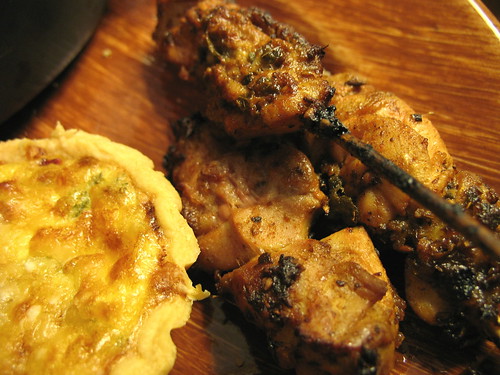
Tartalitas de Pimiento
As you might have guessed from the name, these are little tarts made with roasted peppers. They're similar to quiche, but the filling is a bit lighter because they contain more cream than egg.
*adapted from Spanish by Pepita Aris*
1/2 cup (approximately) jarred, roasted piquillo peppers, drained, patted dry, and cut into thin slices
1 1/2 cups all-purpose flour
1/4 teaspoon salt
6 tablespoons chilled butter, cubed
2-3 tablespoons ice-cold water
4 tablespoons heavy cream or crème fraîche (I used the latter because that's what I had)
1 egg
1 teaspoon thyme leaves, chopped
salt and freshly ground pepper, to taste
1-2 tablespoons freshly grated Parmesan cheese
Equipment: a biscuit cutter; 10 or 12 tartlet pans (approximately 3" in diameter) or a muffin pan
Pulse the flour and salt in a food processor to combine. Add the butter and pulse until it is in pea-sized or slightly smaller clumps. (Alternatively, you can incorporate it with a pastry blender or two knives; if you are new to pastry-making there's a photo and explanation of the latter technique here). With your iced water close by, turn on the machine and add 2 to 3 tablespoons, one after another. (I needed the third tablespoon; you likely will too). Allow the machine to run just long enough for the dough to start to come together — probably not longer than 4 or 5 seconds. Turn the dough out onto a sheet of wax or parchment paper or plastic wrap and gently pat it together to form a flattened ball. Wrap it in plastic wrap and chill it for 20-30 minutes in the refrigerator.
Heat the oven to 400° F.
Roll the dough out thinly on a lightly floured surface and cut 10 or 12 circles with a large biscuit cutter (about 3" in diameter). The number of circles you'll need will vary depending on the size of your tartlet pans; mine are about 3" in diameter and I needed 10). Line the tart pans with the dough, rolling the circles a little thinner if you find that they're too small. Prick the unbaked tartlet shells with a fork and fill them with pie weights, dried beans, or crumpled aluminum foil. Bake for 10-15 minutes, or until just beginning to brown.
Remove the weights or foil from the partially-baked tartlet shells and divide the pepper strips among them.
In a small bowl (preferably one with a spout for pouring), whisk together the cream or crème fraîche, the egg, and the thyme leaves. Season this mixture with salt and pepper and pour into the tartlet shells over the peppers. Sprinkle the grated Parmesan on top of each tartlet and bake for 15 minutes, or until firm and lightly browned. Cool them for 2 minutes in the pan, then remove from the molds and cool on a wire rack. Serve warm or at room temperature.
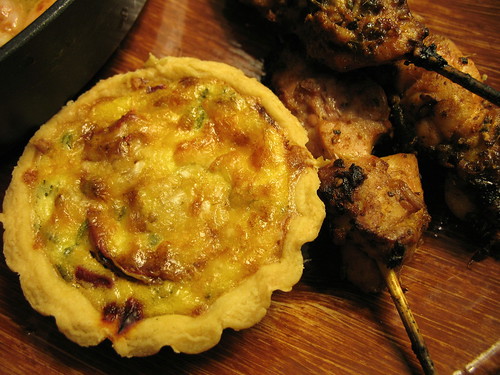
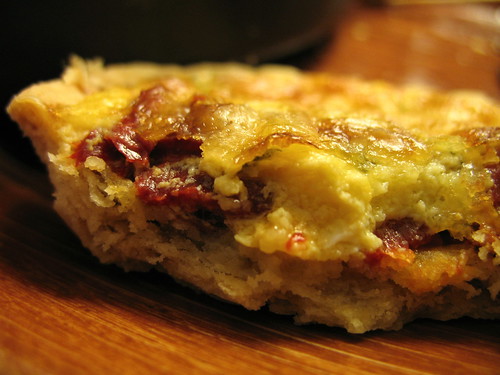
other tapas
We also had gambas al ajillo, shrimp in garlic sauce, which I made with some nice, small Maine shrimp; they were too bubbling-hot for me to get a decent photo of them, and by the time they'd cooled down we'd eaten them and mopped up the sauce with crusty bread. This has become one of my favorite ways to prepare shrimp and once you've tried this recipe from La Tienda once, you probably won't need more than a glance at it again because it is very, very simple. Note that the recipe is for main course-sized servings for 4, with rice; it's excellent that way but you can easily scale down the shrimp for an appetizer. Also, it's flexible enough to permit cutting down on the butter and olive oil and omitting the broth.
The remaining shrimp ended up in scrambled eggs with scallions and parsley the next night.
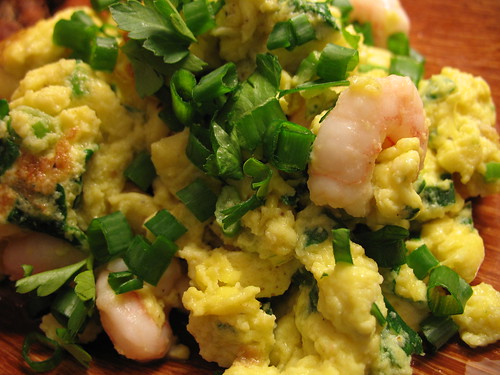
There's a recipe for this dish in the Aris book too — revuelto de gambas — but it's something I've prepared several times in the past without knowing the Spanish name for it. It can be found on the menu in some Chinese restaurants too, but without the parsley. To make this dish, beat some eggs and season them with salt and pepper. (Anywhere between 4 and 8 eggs is fine; it depends on how many people you want to serve). Chop half of one small bunch of scallions and sauté them in a mixture of butter and olive oil until they wilt. Add the eggs and some shelled shrimp and cook, stirring, for a couple minutes, or until the eggs are softly set and the shrimp are just cooked through. (If you are using larger shrimp than the ones in the photo above, you may want to add them to the pan and cook them for a few moments before you add the eggs). While the eggs and shrimp are cooking, chop the rest of the scallions and a couple tablespoons of flat-leaf parsley. Sprinkle this mixture on top of the cooked eggs and serve at once. Don't be tempted to chop all of the scallions at once; the ones that have sat on the cutting board while the eggs cook will taste soapy. (I wish I could remember where I first read this; all I know is that it's true and it is to be avoided).
If you are looking for more tapas recipes, there are loads of them at La Tienda. Oddly, I don't see one for a basic tortilla; there's a nice-looking one here at Too Many Chefs, and a heartier Portuguese one with chorizo at Leite's Culinaria.




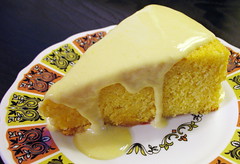
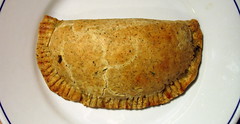


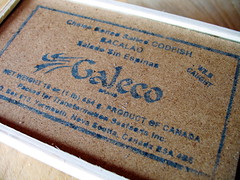







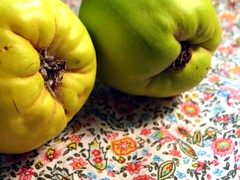

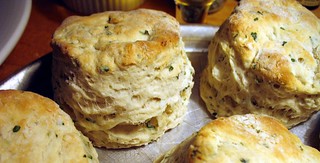
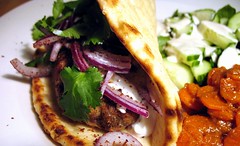
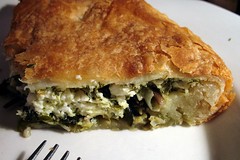


I can't believe someone who's name means "Pumpkin Seed" in Spanish wrote a cookbook.
ReplyDeleteThat's freakin' awesome